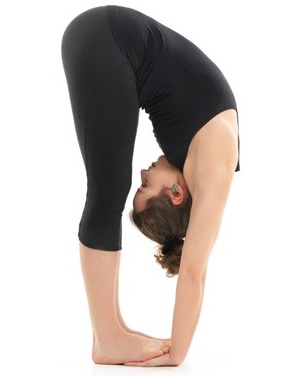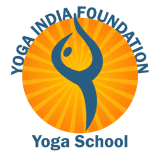
Padahastasana is also known as Hand to Foot Pose. It is practiced during the Surya Namaskar or Sun Salutation. Padahastasana massages and tones the digestive organs while increasing flexibility in your calves and hamstrings. It can also release excess Vata (air) from your abdomen and improve blood circulation.
- Stand with the spine erect, feet together and hands beside the body
- Relax your body
- Distribute the weight of the body evenly on both feet
- Slowly bend forward
- While bending forward, imagine that the body has no bones or muscles
- Do not strain or force the body
- Place the fingers underneath the toes or catch your ankles
- Relax the back of your neck
- Maintain your legs and knees active, they should remain straight
- Take a few deep breaths
Benefits of Padahastasana
- Massages the digestive organs
- Alleviates flatulence, constipation, and indigestion
- Spinal nerves are stimulated and toned
- Increases vitality
- Improves the metabolism
- Improves concentration
- Helps with nasal and throat diseases
Contra-indications of Padahastasana:
Padahastasana should not be practiced by people suffering from serious back complaints, sciatica, heart disease, high blood pressure, or abdominal hernia. It is also not advised for pregnant women especially during the second or third trimester.
Preparations for your practice
It is always recommended to include a 10-minute warm-up prior to your asana practice. Why? Because it helps your body to actually prepare, remove stiffness, increase flexibility and smoothen your joints. Did you know that many modern yoga styles ignore the warm-up and therefore risk serious injuries? No matter if you are a beginner or advanced practitioner, make sure to add your warm-up. In traditional hatha yoga, this is called Pawanmuktasana and includes simple rotations and movements of the toes, ankles, knees, hips, shoulder, elbows, wrists, and neck.
Diving into the next level of yoga
To be sure that you practice an asana correctly, we recommend participating in a Yoga Teacher Training Program. This is an intensive educational program in which you can learn yoga from A to Z. It takes you from understanding the alignment and benefit of each posture to the anatomy, philosophy, meditation, and pranayama aspects. Yoga is very broad and includes many sub-branches such as Ayurveda, healthy diet, nutrition, lifestyle choices, and cleansing techniques. All those are part of the 200 Hour Yoga Teacher Training at Yoga India Foundation in India.
We invite you to take part in this transformational Yoga Teacher Training in India journey and encourage you to grow and evolve!
